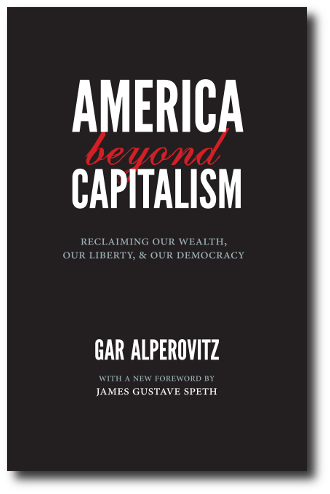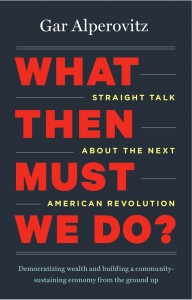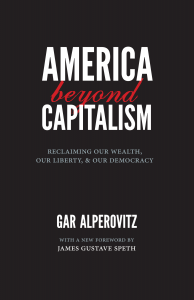(This article first appeared in the November 15, 2007 issue of The Chronicle of Philanthropy)
By Gar Alperovitz, Steve Dubb, and Ted Howard
As the 2008 elections approach, many nonprofit groups that focus on fighting poverty, aiding decaying cities, creating jobs, and closing the growing gap between rich and poor people have begun to hope that a shift in presidential power toward the Democrats, and a tighter hold on Congress, would open a significant flow of federal money.
Stark fiscal trends, however, suggest both that such hopes will be disappointed and that very different approaches will be required to deal with issues of growing concern. Nonprofit groups will be a big part of the solution.
With help from foundations and other supporters, nonprofit organizations have pioneered efforts to build the assets of poor people and their neighborhoods, and those efforts will need to be greatly expanded. What’s more, new projects will have to be started to encourage colleges, hospitals, and other large nonprofit groups to change how they do business. Already a small number of such institutions are making efforts to buy products locally and make investments in businesses that can help create wealth and anchor capital
in disadvantaged communities, but far more need to do so.
It has long been clear that government is not going to expand its efforts to take care of the causes foundations and charities care about. For instance, discretionary federal domestic program spending — which includes housing, education, environmental protection, transportation, homeland security, and much else — fell from 5.2 percent of gross domestic product in 1980 to 3.8 percent in 2006. Such spending is projected to decline to 2.8 percent of the gross domestic product in 2012. Federal spending for community development has declined from a mere 0.3 percent of the GDP in 1980 to 0.06 percent today.
Progressive taxation of upper-income groups has also fallen for almost half a century, with only modest variations under Democratic and Republican administrations. Top marginal tax rates were 91 percent under President Dwight Eisenhower in the 1950s; today they are 35 percent.
Corporate taxes have declined from 30 percent of federal revenues in the 1950s to 10 percent now (a mere 2 percent of GDP). Given the deficit, the Iraq war, and possible new federal health care and retirement benefits, it is very unlikely much new government aid will be available for domestic causes for years to come.
In the face of these ever-tightening fiscal trends, a broad range of new efforts to increase the wealth of individuals and communities has begun to emerge. Most do not involve large-scale expenditures by government or charities. They depend for their success on harnessing — and changing the ownership of — wealth in ways that benefit needy people. Moreover, owning assets — equity in a home, shares in the business one works for — not only brings income, but also provides a measure of economic security and creates long-term ties to the community.
The most well-known approach is the individual development account, through which community-development groups match the savings of low-income people. Already, more than 50,000 individuals are accumulating modest levels of assets through these programs. But plenty of other efforts are under way.
Employee ownership was once seen as a radical demand, but it is now commonplace. Nearly 10,000 companies are owned by employees; the 10.5 million people who work at those businesses represent more than the entire membership of labor unions at private companies. Such companies almost never get up and move abroad. Employee-owned businesses also provide critically important tax revenue to city- and state-government coffers that pay for local services. At the same time, they create widespread local worker ownership of productive assets. The value of workers’ stakes in these businesses totals more than $670-billion, or $64,000 per employee.
Some wealth-building efforts combine the idea of increasing assets of individuals and of an entire community. A community land trust, for example, is essentially a locally based nonprofit organization that owns land on behalf of the community and sells homes to low-income families under special arrangements: In exchange for a low price, the family agrees that if it one day decides to sell, only limited profits will be taken — thereby keeping the property permanently affordable for other low- and moderate-income families.
Even so, individuals still can attain significant gains in equity. In Burlington, Vt., the average equity gain (over an average period of six years) was $5,000 to $8,000 per household — a significant sum given the earnings of the people who lived there. Community land trusts can now be found not only in places like Burlington, but also in cities like Chicago and Irvine, Calif. By 2025, Irvine expects to develop almost 10,000 units of land-trust housing, which will represent 10 percent of its total housing stock.
Among the most interesting and important new approaches are those aimed at focusing the business decisions and priorities of “anchor institutions” in ways that benefit disadvantaged neighborhoods. Universities, hospitals, and other nonprofit groups are beginning to get serious about spurring wealth creation, especially as they decide how to channel big-scale purchases, acquire real estate, and make investment choices.
Some anchors have done so simply as good members of the community. Often, self interest in reducing crime and creating an environment that enables anchor institutions to attract and retain students, faculty, and doctors plays a critical role.
The amount of money that large nonprofit institutions have the potential to channel into the economies of cities is significant. Higher-education institutions alone spend $350-billion a year, and their endowments now top $300-billion. One study found that colleges in urban areas spent nine times more than the federal government spends on all of its urban housing and job-development programs combined.
In America’s 20 largest cities, 35 percent of the 1.6 million people who work for the 10 biggest private employers in each city are employed by higher education, their medical facilities, and other hospitals. When such organizations devote even a small amount of their purchasing and investments to help needy people increase their assets, they can make a big difference.
The University of Pennsylvania, for instance, increased its purchasing from local vendors in West Philadelphia from $20.1-million in 1996 to $61.6-million in 2003, thereby helping to attract an additional $370-million in private investments to local businesses.
In 2006 the university channeled $72.1-million, or roughly 10 percent of its total spending, to local businesses, with a goal of spending $120-million locally by decade’s end. Penn also works to ensure that local community residents get jobs on its construction projects and that they are given priority in hiring at the buildings that have been added to the campus.
In the last few years, several foundations have begun innovative efforts focused on anchor institutions. For instance, the Cleveland Foundation is working with the city’s major anchor institutions to develop a coordinated effort to revitalize the six impoverished neighborhoods near Case Western Reserve University, the Cleveland Clinic, and the surrounding “University Circle” district. Central to the approach is persuading anchor institutions to commit to channel some of their spending on major purchases to local community- and worker-owned firms.
In Rochester, Minn., the Mayo Clinic (which employs 28,000 people in a city of 95,000) invested $7-million in First Homes, a program started by the Rochester Area Foundation to alleviate a severe housing shortage. The foundation used the clinic’s investment to attract more than $100-million for low-cost housing. To date, the effort has resulted in nearly 50 community land-trust properties, 420 single-family homes, and more than 225 below-market-rate rental units.
In Ohio, the University of Akron and other anchor institutions are trying to build local businesses and increase homeownership in the 40 blocks that surround the campus. A 2001 grant of $3-million from the John S. and James L. Knight Foundation helped to attract more than $150-million in government and private investments to the effort. Knight has since pledged an additional $10-million to support the university’s plan.
Given the accomplishments of such efforts, grant makers that seek to curb poverty and urban dislocation would do well to finance additional projects that mobilize colleges and other institutions to use their resources in ways that benefit poor people. This might be politically shrewd for the anchors at a time of increasing criticism of huge endowments and talk of a new legal minimum payout for such endowments. And foundations might both increase the influence of their limited dollars and just possibly establish the basis for longer-term policy developments as fiscal constraints continue to force changes in government programs in coming years.
Gar Alperovitz, author of America Beyond Capitalism, is a professor of political economy at the University of Maryland at College Park and a founder of the Democracy Collaborative, an organization based at the university that promotes approaches to building community wealth. Ted Howard is executive director of the Democracy Collaborative. Steve Dubb is the collaborative’s senior research associate.
 AMERICA BEYOND CAPITALISM
AMERICA BEYOND CAPITALISM



 Agenda
Agenda  Posterboard
Posterboard 